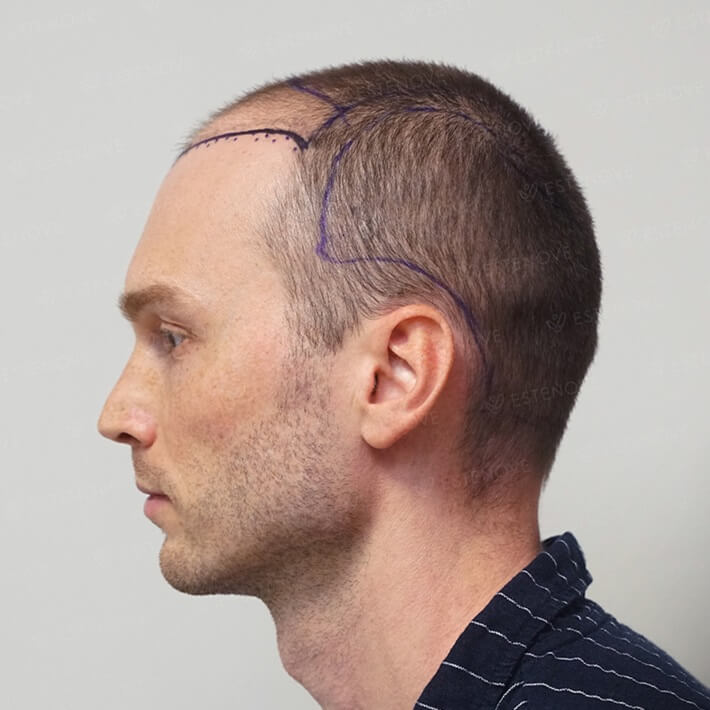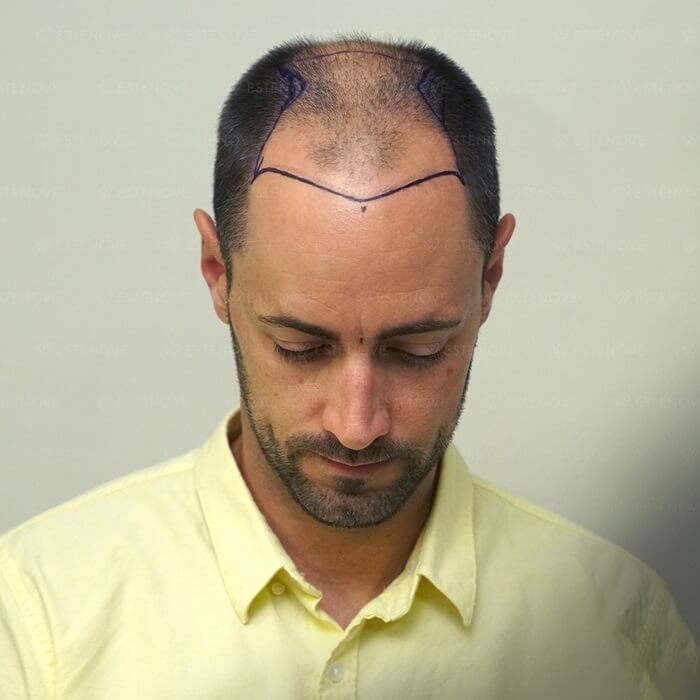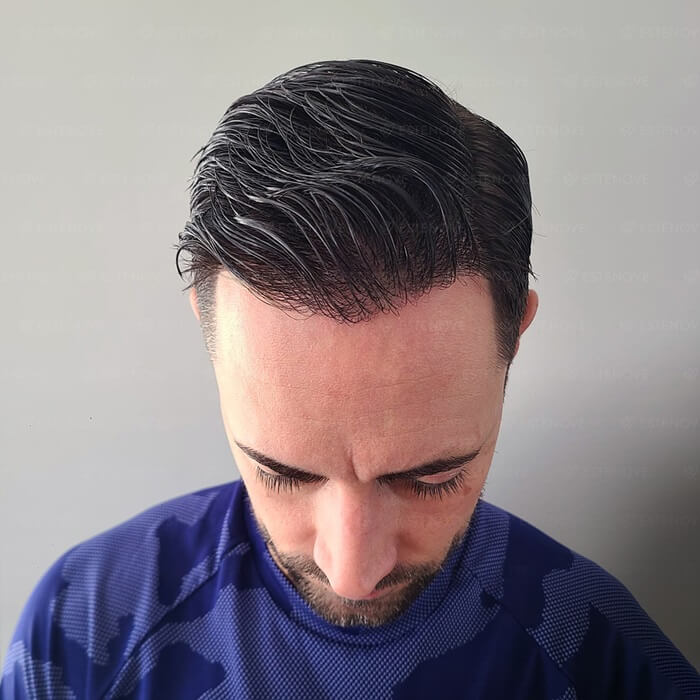GET FREE HAIR ANALYSIS
Please fill in the form below to get your free hair analysis.
| Country | Estimated Cost | # of Sessions |
|---|---|---|
| Estenove |
Please fill in the form below to get your free hair analysis.
Our interactive Hair Graft Calculator is more than just a numbers tool—it’s designed to help you plan your hair restoration journey with clarity and confidence. Here’s what you can do with it:
Using the illustrated head diagram, you can easily select the exact zones affected by hair loss. This intuitive selection automatically calculates the average number of grafts and hair follicles you may need—no guesswork, no confusion.
Whether you’re experiencing a receding hairline, thinning crown, or patchy spots, the calculator estimates how many grafts are required to restore each selected area. For example, selecting Areas 1, 2, and 3 may result in a total of 2,750 grafts and 5,337 hairs.
After estimating your graft need, simply choose a country (e.g., USA, Germany, United Kingdom) to see real-time cost comparisons. This gives you a transparent view of pricing differences between Turkey and other popular hair transplant destinations.
Whether you’re budgeting for treatment, researching destinations, or preparing for a consultation, this tool helps you take the next step with informed expectations—tailored to your unique pattern of hair loss.
Hair grafting is a surgical procedure that aims to restore hair in areas of thinning or complete baldness. The method involves transplanting hair follicles from a donor site, usually located on the back of the head where hair is typically denser, to an area where hair is desired. This technique focuses on providing a natural-looking result, as it enables the hair to grow in its new location just like it would in its original one.
Hair grafting has gained significant popularity due to its effectiveness and lasting results. It is often recommended for individuals experiencing male or female pattern baldness, traumatic hair loss due to injuries, or hair loss due to medical conditions such as alopecia areata.
The hair grafting process involves several steps that ensure the successful transfer of hair follicles. Initially, a consultation with a qualified specialist is conducted to assess the individual’s hair loss pattern, scalp condition, and overall health. Once a suitable treatment plan is established, the procedure begins.
During the actual grafting process, the surgeon will harvest hair follicles from the donor site using specialized instruments. These follicles, which can consist of one or multiple hairs, are carefully extracted and prepared for transplantation. The surgeon then creates tiny incisions in the recipient area and places the grafts into these incisions. This meticulous process allows for precision in both density and direction of hair growth.








There are primarily two techniques used in hair grafting: Follicular Unit Extraction (FUE) and Direct Hair Implantation (DHI). Each method has unique features that may appeal to different patients, depending on their needs and conditions.
FUE hair grafting is a minimally invasive technique that involves extracting individual follicular units from the donor area. This method is favored for its ability to produce natural results while minimizing scarring and downtime. Recovery is usually quicker than with FUT, allowing patients to return to their normal activities faster.
FUE is particularly beneficial for those who prefer shorter hairstyles, as the risk of scarring is significantly lower. It is also applicable for eyebrow and beard transplants, showcasing its versatility.
DHI, or Direct Hair Implantation, is an advanced technique that takes FUE a step further. With DHI, the surgeon uses a specialized tool to implant the hair follicles directly into the recipient area without creating prior incisions. This method allows for increased precision in placing the grafts and can result in a denser coverage.
The DHI technique typically requires fewer sessions than traditional methods and is known for its quicker recovery time. However, it is essential to consult with a qualified provider to understand its suitability for individual cases.
The number of grafts required for a hair transplant can vary significantly depending on the extent of hair loss and the desired density. On average, patients may receive anywhere from 1,000 to 4,000 grafts in one session. A thorough consultation with a hair restoration specialist will determine the specific needs based upon the individual’s hair restoration goals.
Ultimately, the goal is to achieve a natural-looking hairline and adequate coverage in bald areas. The specialist may use tools like 3D imaging to visualize potential outcomes based on the number of grafts.
Determining the number of grafts needed is a personalized process. The number of hair grafts needed depends on the severity of hair loss, the size of the balding area, and individual hair characteristics. Most hair restoration specialists employ a detailed evaluation system to estimate graft counts based on individual cases.
Additionally, patients seeking hair grafting should also consider their expectations for density and hairline design, as these elements influence the overall number of grafts required for a successful procedure.
Our graft calculator tool is designed to provide prospective patients with an estimate of how many grafts they might need for their hair transplant surgery. Use the hair graft calculator above to estimate the number of grafts needed for your procedure and compare costs across different destinations.
The cost of hair grafting varies significantly based on several factors, including the technique used, the number of grafts required, the geographic location of the clinic, and the surgeon’s experience. On average, patients might expect to pay between $3,000 and $15,000 for the procedure.
It is advisable for individuals considering hair grafting to inquire about all potential costs during the initial consultation to avoid unexpected expenses. Make use of the hair graft & cost calculator above to estimate cost for your hair transplant operation.
On average, one graft can contain one to four hair follicles, depending on the thickness and density of the hair being harvested. Grafts that contain multiple follicles can be beneficial for creating a fuller appearance in areas requiring more coverage. Understanding the potential yield of each graft is vital for both patients and doctors during the planning process.
The number of grafts required for restoring the hairline can range from 600 to 2,000 grafts, depending on the extent of recession and desired density. A well-defined hairline can be achieved by strategically placing the grafts to create a natural transition between the hairline and the existing hair.
A experienced surgeon will often tailor the number of grafts to suit the aesthetic goals of the patient, ensuring the final appearance remains natural and in harmony with the rest of the hair.
One of the most appealing aspects of hair grafting is its permanence. Once transplanted, the hair follicles are usually resistant to the factors that caused hair loss, meaning they can grow and thrive in their new location. However, it is vital for individuals to maintain realistic expectations, as new hair growth can take several months to appear.
Moreover, while the transplanted hairs are permanent, patients may experience continued hair loss in other areas. In such cases, follow-up procedures might be necessary to maintain a fuller look.
After a hair transplant, grafts typically begin to stabilize within the first week. By days 10 to 14, much of the initial swelling and redness will have subsided, and the grafts become firmly integrated into the scalp. Most surgeons advise patients to avoid strenuous activities that could disrupt the grafts for at least two weeks post-operation.
Long-term, patients should be aware that newly implanted hair may shed temporarily before the growth cycle resumes, which is a normal part of the healing process. Check out the hair transplant recovery timeline for detailed overview with hair transplant patients’ photos.
Hair grafting presents several advantages over alternative treatments such as topical medications or laser therapy. Firstly, it offers a permanent solution to hair loss, while other treatments may require ongoing use to maintain results. Additionally, the results of hair grafting are often immediate and measurable once the hair begins to grow.
Moreover, hair grafting is tailored to each individual, allowing for personalized treatment that addresses specific concerns. Patients appreciate the natural appearance achieved through grafting, as transplanted hairs continue to grow like their natural hair.
During the hair grafting procedure, patients can expect an initial consultation where they discuss their goals and review their hair loss pattern. On the day of the procedure, anesthesia is administered, ensuring comfort throughout the operation. The procedure itself can take several hours, depending on the number of grafts being transplanted.
Post-procedure, patients may experience minor discomfort or swelling, but follow-up care instructions from the surgeon will help manage these symptoms effectively. Adequate recovery is essential for optimal results.
While hair grafting is generally safe, it is essential to recognize potential risks and complications. These can include infection, scarring, and unnatural hair growth patterns. However, with proper research and selection of a qualified surgeon, the likelihood of these complications can be minimized.
Patients should be proactive in discussing any concerns with their surgeon during the consultation, ensuring clarity on what to expect and how to care for their newly transplanted hair.
Long-term results from a hair grafting procedure can be highly rewarding. Patients can anticipate natural-looking hair growth that can last for years, if not a lifetime, provided they take appropriate care of their hair and scalp.
Regular check-ups with the hair restoration specialist can enhance the longevity of the results, allowing for adjustments or additional treatments as necessary to maintain appearance. This proactive approach aids in ensuring sustained confidence for those struggling with hair loss.
Explore real-life hair transplant success stories featuring detailed videos, before-and-after photos, and insights into operation types and procedures.